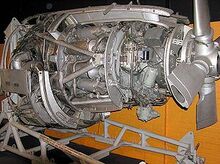
"I shall hate (the Proteus) to my dying day because of the way, whenever we thought we had the problems licked, a new one would suddenly emerge – at the worst possible moment”
Sir Stanley Hooker, jet engineer, in his autobiography, 1984
The Bristol Proteus turboprop* was the first production gas turbine engine made in the Bristol Aeroplane Co. It was designed to power the Bristol Brabazon II airliner and the Saunders Roe Princess flying boat, neither of which went into production. Its development was plagued by problems, but it eventually became a successful engine producing over 3,600 horsepower and it pioneered a wide range of new uses for aero turbines.
Proteus engines were installed in the Bristol Britannia airliner, nicknamed the “Whispering Giant”. Intake icing problems delayed the Britiannia until 1957 and airlines opted for new jets like the Boeing 707. Only 85 Britannias were built but they served operationally for decades. The last one retired in 1997 and is preserved in Kemble. This engine is a Mk. 255 from one of 23 Royal Air Force Britannias. The RAF flew them for 15 years.
A marine version of the Proteus was installed in the Royal Navy’s three Brave class motor torpedo boats, pioneering the use of gas turbines to propel navy vessels; the boats were capable of 55 knots (About 63 mile per hour) and several other navies bought Proteus-powered boats. Another variant was used to drive electricity generating stations in rural areas, where it could be started by telephone to provide an instant 3 Megawatts of power at peak times. The Proteus also powered the SRN4 cross-Channel hovercraft, experimental hydrofoils, and even broke the World Land Speed Record in Donald Campbell’s “Bluebird” car.
J1768
Purchased by the Museum
*Science bit: a turboprop engine is a form of gas turbine (or “jet”) where most of the power is used to drive the propeller, leaving a little jet thrust from the exhaust. This makes it much more fuel-efficient but limits the maximum aircraft speed. For compactness, the Proteus was designed with “reverse flow”. The air intake is toward the rear and the air flows forwards through the compressor stages in the center of the engine, the compressed air then turns 180 degrees, to flow rearwards through an outer ring of combustion chambers, where it is mixed with fuel and ignited. This hot, high energy, gas drives two sets of turbine wheels before exhausting at the rear of the engine. In the Proteus, one turbine drives the compressor (to keep the whole cycle going) and a separate “free” turbine takes nearly 4,000 horsepower from the hot gas to drive the propeller via a shaft and a gearbox